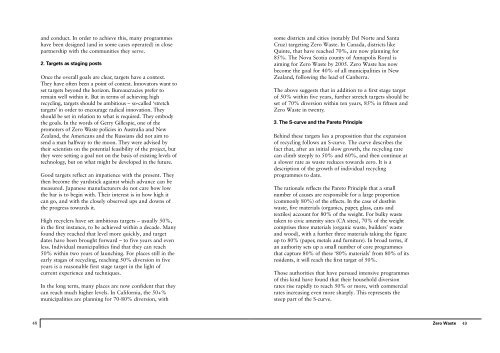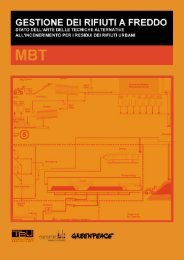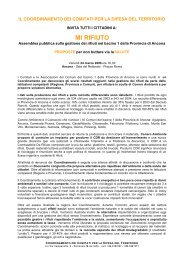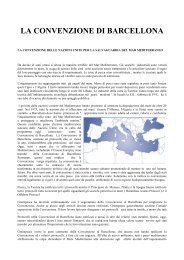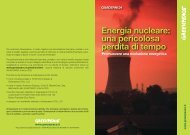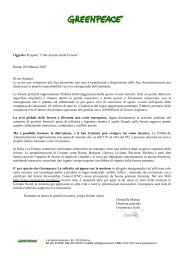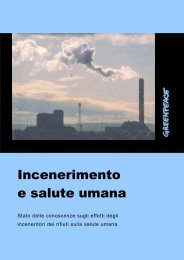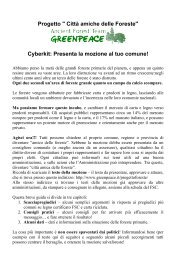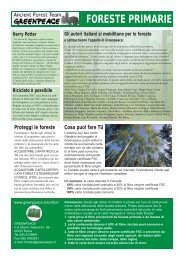Zero Waste by Robin Murray, Greenpeace Environmental Trust 2002
Zero Waste by Robin Murray, Greenpeace Environmental Trust 2002
Zero Waste by Robin Murray, Greenpeace Environmental Trust 2002
You also want an ePaper? Increase the reach of your titles
YUMPU automatically turns print PDFs into web optimized ePapers that Google loves.
and conduct. In order to achieve this, many programmes<br />
have been designed (and in some cases operated) in close<br />
partnership with the communities they serve.<br />
2. Targets as staging posts<br />
Once the overall goals are clear, targets have a context.<br />
They have often been a point of contest. Innovators want to<br />
set targets beyond the horizon. Bureaucracies prefer to<br />
remain well within it. But in terms of achieving high<br />
recycling, targets should be ambitious – so-called ‘stre t c h<br />
t a rgets’ in order to encourage radical innovation. They<br />
should be set in relation to what is re q u i red. They embody<br />
the goals. In the words of Gerry Gillespie, one of the<br />
p romoters of <strong>Zero</strong> <strong>Waste</strong> policies in Australia and New<br />
Zealand, the Americans and the Russians did not aim to<br />
send a man halfway to the moon. They were advised <strong>by</strong><br />
their scientists on the potential feasibility of the project, but<br />
they were setting a goal not on the basis of existing levels of<br />
t e c h n o l o g y, but on what might be developed in the future.<br />
Good targets reflect an impatience with the present. They<br />
then become the yardstick against which advance can be<br />
measured. Japanese manufacturers do not care how low<br />
the bar is to begin with. Their interest is in how high it<br />
can go, and with the closely observed ups and downs of<br />
the progress towards it.<br />
High recyclers have set ambitious targets – usually 50%,<br />
in the first instance, to be achieved within a decade. Many<br />
found they reached that level more quickly, and target<br />
dates have been brought forward – to five years and even<br />
less. Individual municipalities find that they can reach<br />
50% within two years of launching. For places still in the<br />
early stages of recycling, reaching 50% diversion in five<br />
years is a reasonable first stage target in the light of<br />
current experience and techniques.<br />
In the long term, many places are now confident that they<br />
can reach much higher levels. In California, the 50+%<br />
municipalities are planning for 70-80% diversion, with<br />
some districts and cities (notably Del Norte and Santa<br />
Cruz) targeting <strong>Zero</strong> <strong>Waste</strong>. In Canada, districts like<br />
Quinte, that have reached 70%, are now planning for<br />
85%. The Nova Scotia county of Annapolis Royal is<br />
aiming for <strong>Zero</strong> <strong>Waste</strong> <strong>by</strong> 2005. <strong>Zero</strong> <strong>Waste</strong> has now<br />
become the goal for 40% of all municipalities in New<br />
Zealand, following the lead of Canberra.<br />
The above suggests that in addition to a first stage target<br />
of 50% within five years, further stretch targets should be<br />
set of 70% diversion within ten years, 85% in fifteen and<br />
<strong>Zero</strong> <strong>Waste</strong> in twenty.<br />
3. The S-curve and the Pareto Principle<br />
Behind these targets lies a proposition that the expansion<br />
of recycling follows an S-curve. The curve describes the<br />
fact that, after an initial slow growth, the recycling rate<br />
can climb steeply to 50% and 60%, and then continue at<br />
a slower rate as waste reduces towards zero. It is a<br />
description of the growth of individual recycling<br />
programmes to date.<br />
The rationale reflects the Pareto Principle that a small<br />
number of causes are responsible for a large pro p o rt i o n<br />
(commonly 80%) of the effects. In the case of dustbin<br />
waste, five materials (organics, paper, glass, cans and<br />
textiles) account for 80% of the weight. For bulky waste<br />
taken to civic amenity sites (CA sites), 70% of the weight<br />
comprises three materials (organic waste, builders’ waste<br />
and wood), with a further three materials taking the figure<br />
up to 80% (paper, metals and furn i t u re). In broad terms, if<br />
an authority sets up a small number of core pro g r a m m e s<br />
that capture 80% of these ‘80% materials’ from 80% of its<br />
residents, it will reach the first target of 50%.<br />
Those authorities that have pursued intensive programmes<br />
of this kind have found that their household diversion<br />
rates rise rapidly to reach 50% or more, with commercial<br />
rates increasing even more sharply. This represents the<br />
steep part of the S-curve.<br />
48<br />
<strong>Zero</strong> <strong>Waste</strong><br />
49


